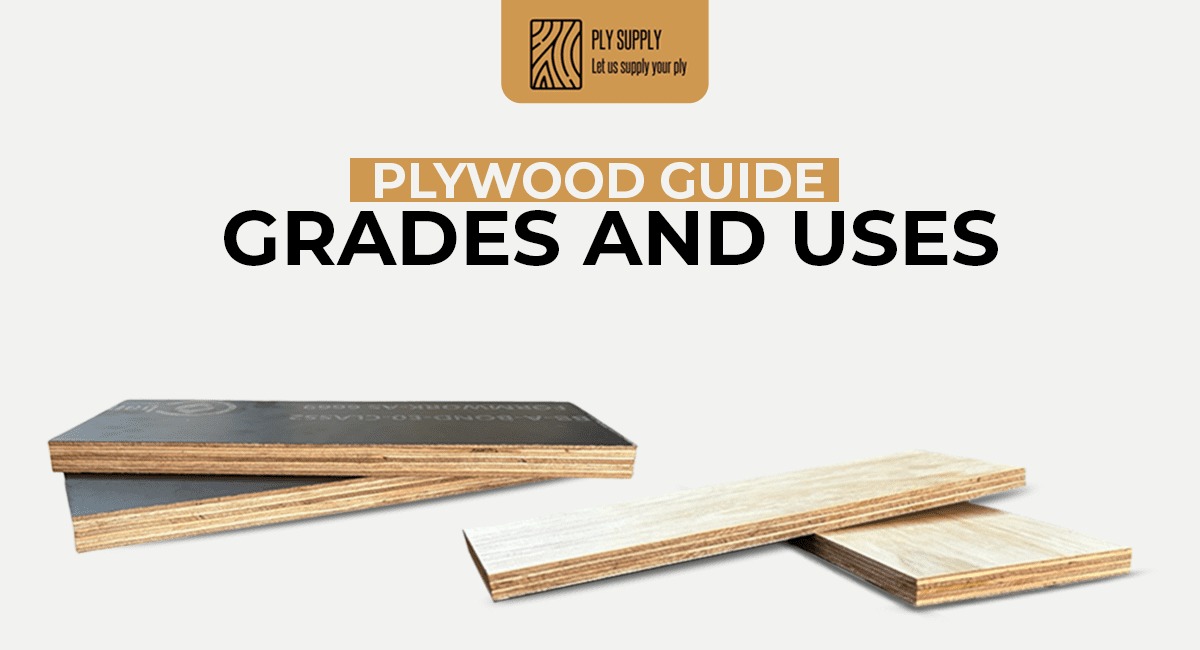Plywood Guide: Grades and Uses
Hardwood Plywood Guide | 10 Benefits & Uses

We’ve all seen plywood – that versatile sheet of wood used for countless projects.
But have you explored hardwood plywood? It’s the cooler, classic and stronger version of plywood, offering appealing looks alongside exceptional durability. Let’s explore more about this sturdy type of plywood. After reading this blog post, you’ll be well-informed about hardwood plywood, including its top benefits and uses.
Ply Supply is your go-to shop for all your hardwood plywood needs in Western Australia.
We offer a premium selection of hardwood plywood sourced from Australia and overseas. With a variety of options to suit any project and budget, we carefully chose it for its quality and reliability. So, here you’ll find the perfect fit for any structural need, decorative touches, or anything in between.
Keep reading to get valuable knowledge and contact us directly to get the best plywood for your next project.
What is Hardwood Plywood? How it is Made?
Hardwood plywood is a carefully crafted sheet material made from layers of thin wood veneer securely bonded together.
These layers, made from hardwoods such as walnut, birch, and poplar, are stacked and glued in a cross-grain pattern. This construction gives hardwood plywood exceptional strength and durability, making it heavier and more resilient compared to softwood plywood.
It’s ideal for both outdoor and indoor projects due to its robust nature.
Hardwood plywood at Ply Supply stands out for its superior quality and smooth finish. It resists splitting when screws or nails are used and shows minimal expansion and shrinkage over time. This makes it an ideal choice for a wide range of applications.
Let’s move towards its step-by-step making process:
Hardwood Plywood Manufacturing Process | 9 Easy Steps
Step 1: Log Preparation and Debarking
Before the plywood creation begins, logs are carefully measured and cut to size. A debarking machine then removes the bark from the logs, ensuring they are prepared for the next stage of production.
Step 2: Veneer Peeling and Clipping
Using a rotary lathe, the logs are peeled into thin sheets of veneer. These veneers may be clipped to predetermined sizes to remove any defects. The quality of these veneers is crucial as they determine the grade of the plywood.
Step 3: Drying the Veneer
Freshly peeled veneers contain moisture and are dried in continuous or roller dryers. Proper drying ensures the veneers are ready for bonding, reducing the risk of warping or defects.
Step 4: Veneer Composition
Once dried, the veneers are sorted into face, core, and back layers. The face veneer is the visible surface, the back is unseen, and the core provides structural support. They are then assembled into standard sheet sizes, ensuring uniformity in thickness and quality.
Step 5: Bonding with Adhesives
Layers of veneer are bonded together using adhesives appropriate for the type of plywood being produced. This bonding process involves applying adhesives evenly between layers and pressing them together to create strong, cross-grained sheets.
Step 6: Cold and Hot Pressing
The assembled panels undergo cold pressing to begin bonding and then hot pressing to finalize the process. This step ensures the adhesive cures properly, creating a dense and uniform plywood sheet with consistent strength.
Step 7: Sanding and Trimming
After pressing, the plywood sheets are sanded to achieve a smooth surface and uniform thickness. Depending on market requirements, sanding may be done on one or both sides of the plywood. Sheets are then trimmed to their final dimensions.
Step 8: Quality Control
Each plywood panel undergoes rigorous quality checks for mechanical strength, bonding durability, and formaldehyde emissions. Any imperfections are corrected, ensuring only high-quality plywood reaches the market.
Step 9: Packaging and Shipment
Finally, the finished plywood sheets are carefully packed, stacked, and stamped with grade markings for identification. They are then ready for distribution to local and international markets, meeting various construction needs.
Top 10 Benefits of Hardwood Plywood
Beautiful & Polished Look
One of the first things you’ll notice about hardwood plywood is its striking appearance. With high-quality outer layers that mimic the beauty of real wood, and are enhanced by top-notch veneers, plywood can compete with the elegance of solid wood.
Long-lasting Durability
Thanks to its uniform strength, plywood can endure significant stress over time, surpassing solid wood and other engineered materials in durability.
Lightweight Advantage
It’s one of the most obvious benefits of hardwood plywood. Despite its strength, hardwood plywood is surprisingly lightweight. This makes it easier to handle and manipulate during furniture making and other projects compared to heavier solid wood.
Strength and Reliability
While solid wood is known for its strength, modern hardwood plywood is equally robust. Its layered construction, bonded with strong adhesives at different angles, creates a cross-grain structure that distributes weight evenly. This makes plywood a reliable choice for demanding applications.
Versatility in Size
Hardwood plywood comes in large sheets, which is advantageous compared to solid wood. This allows for easier planning and reduces material wastage whether you’re building furniture or installing flooring.
Efficient Coverage
The large dimensions of hardwood plywood sheets mean they cover more area efficiently during construction projects. This reduces the need for multiple pieces and minimizes waste, ensuring a smoother installation process.
Flexibility for Curves
Unlike solid wood, hardwood plywood bends smoothly to fit curved surfaces without splitting. This flexibility makes it ideal for creating unique designs and architectural features with ease.
Greater Properties
Modern hardwood plywood can be treated to enhance its properties, such as fire resistance and moisture protection. This makes it comparable to treated solid wood but at a more cost-effective price point.
Cost-Effective Solution
Hardwood plywood offers excellent value for money compared to solid wood. Its efficient use reduces material and labour costs, and its lightweight nature makes transportation more economical.
Environmentally Friendly Choice
Despite being made from wood, hardwood plywood has a lower carbon footprint than solid wood due to its efficient manufacturing process. It conserves more timber and is considered a sustainable option for eco-conscious projects.
Common Uses of Hardwood Plywood
- Furniture Making: Ideal for crafting high-quality, durable furniture pieces.
- Cabinetry: Perfect for kitchen and bathroom cabinets due to its strength and attractive finish.
- Flooring: Provides a durable and visually appealing flooring option.
- Architectural Panels: Used in decorative wall panels and ceilings for both aesthetic and functional purposes.
Need top-quality plywood for furniture or any exterior interior project?
Find the Most Durable Hardwood Plywood at Ply Supply
We’re Australia’s leading plywood supplier.
Whether you need structural plywood for robust construction projects, non-structural plywood for versatile activities, or high-quality hardwood plywood for any application, we’ve got you covered.
Our extensive selection of plywood ensures you’ll find the ideal plywood that meets your every requirement for quality, durability, and reliability.
